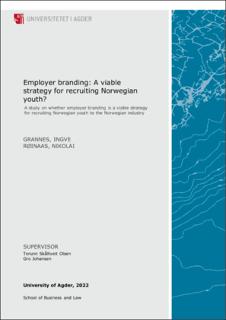Employer branding: A viable strategy for recruiting Norwegian youth?
Master thesis
Permanent lenke
https://hdl.handle.net/11250/3036464Utgivelsesdato
2022Metadata
Vis full innførselSamlinger
Sammendrag
The purpose of this thesis is to investigate if, and explain how, employer branding may be used for recruiting Norwegian youth to the Norwegian industry. This thesis looks at employer branding in light of relevant literature, theories, and frameworks. It looks at some of the challenges and possibilities in the industry, especially in the coming years, and how employer branding can help with recruitment of Norwegian youth. It uses Glencore Nikkelverk as a practical example of how implementations of the results can help recruitment for a firm in the Norwegian industry and better shape them for the future.
The study is a qualitative study, with an explorative research design in which we compare the results from nine different interviews to seek an answer to our research question. We used data triangulation in order to gather different perspectives on the subject. The collected data were retrieved through semi-structured interviews that took place in Agder county in order to gain a local perspective on the challenges.
Our findings show that there are multiple challenges in recruitment to the industry, and not all of them can be solved by a company. There are a lot of political and resource-related challenges, but the findings did also provide answers to the supportive questions which in turn can be used to develop an efficient employer branding plan.
Our findings further suggest that an employer branding strategy should focus on improving employer image towards the youth and use employer brand associations and relevant organizational attributes to do so. The most relevant organizational attributes were found to be compensation and organizational culture, as these were the two most mentioned by advisors in high schools providing vocational studies. The thesis also gives recommendations to which promotion/communication channels that can optimize an employer branding strategy. It was found that company visits/presentations and media/social media were the most influential.
